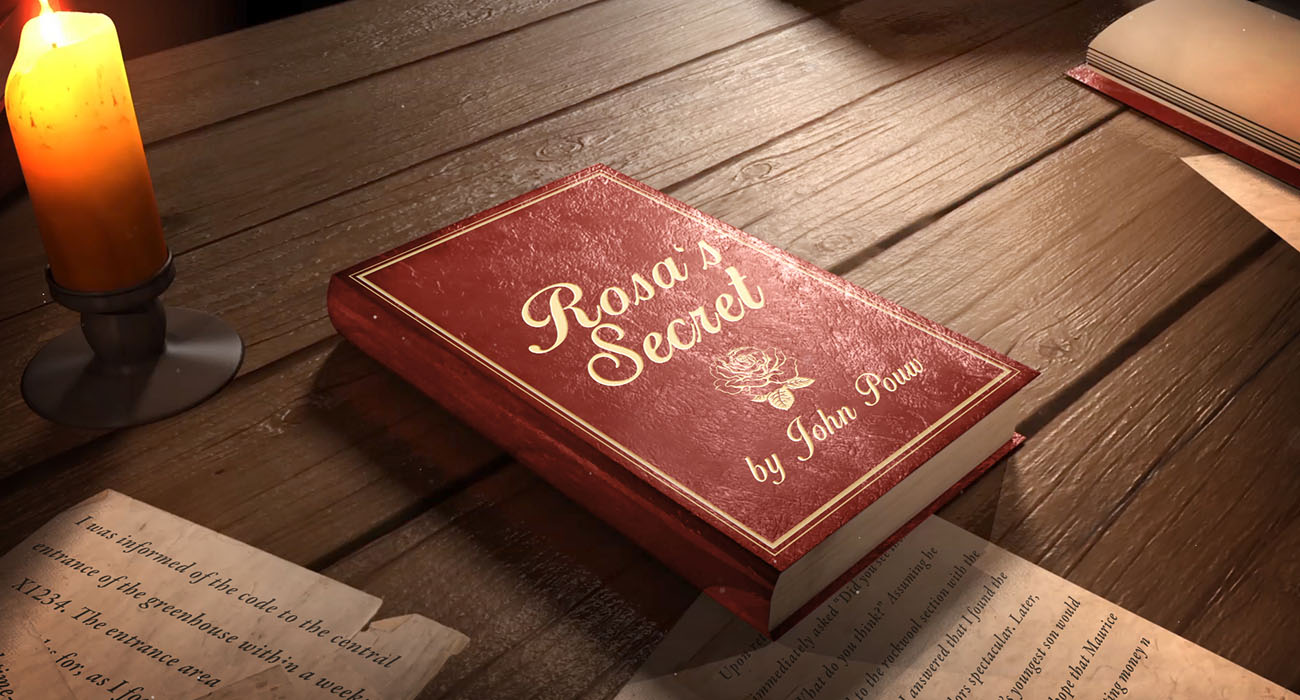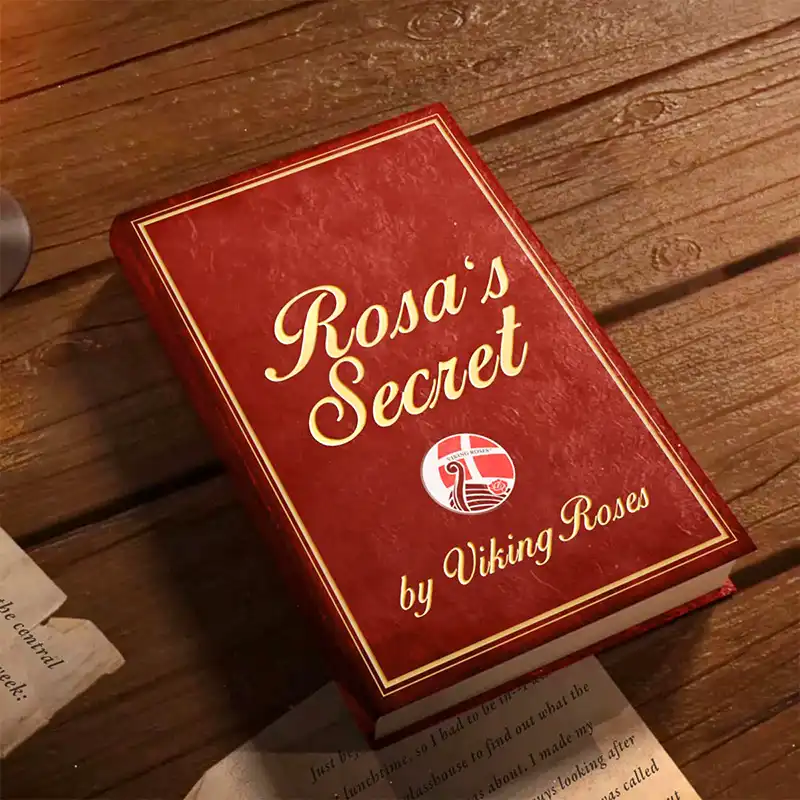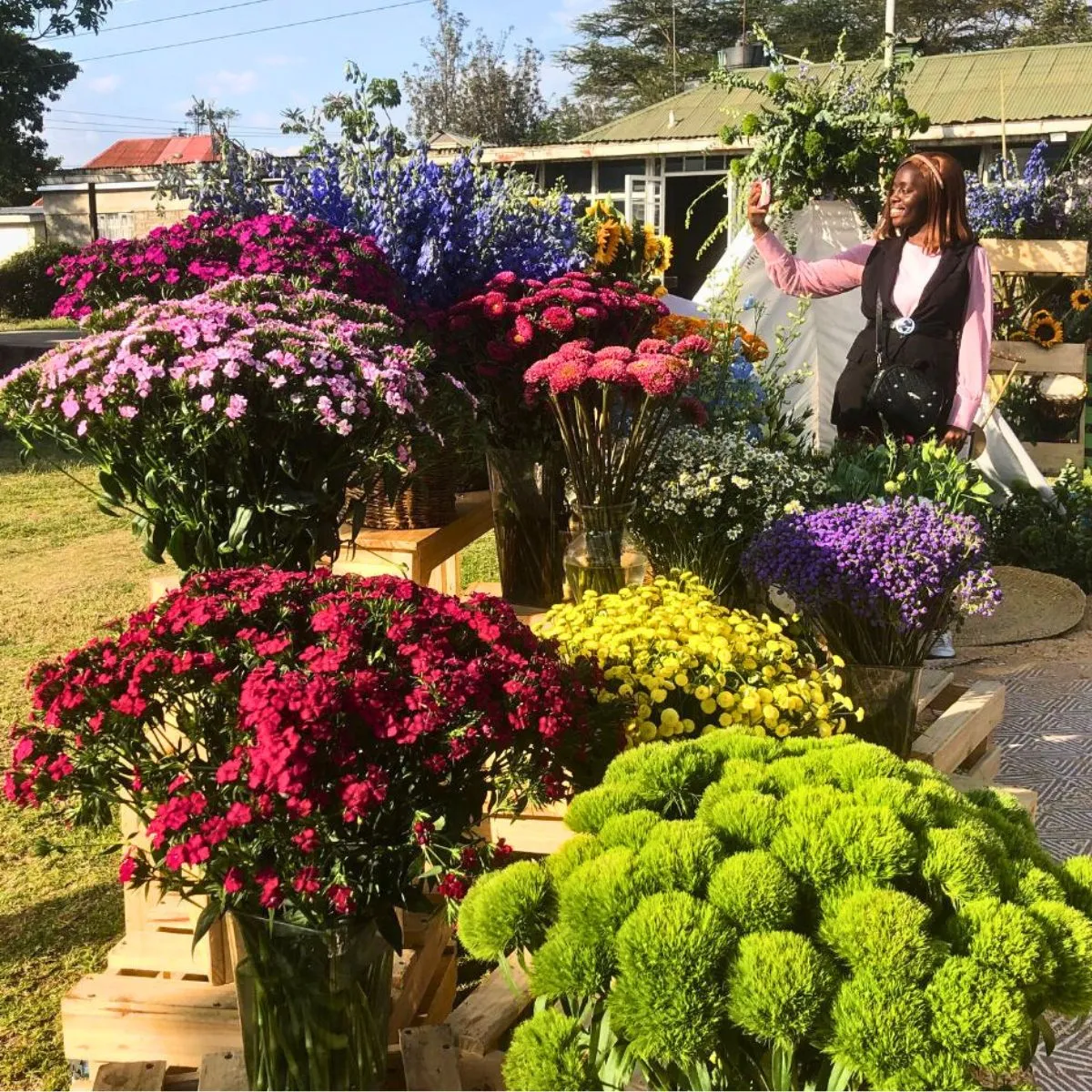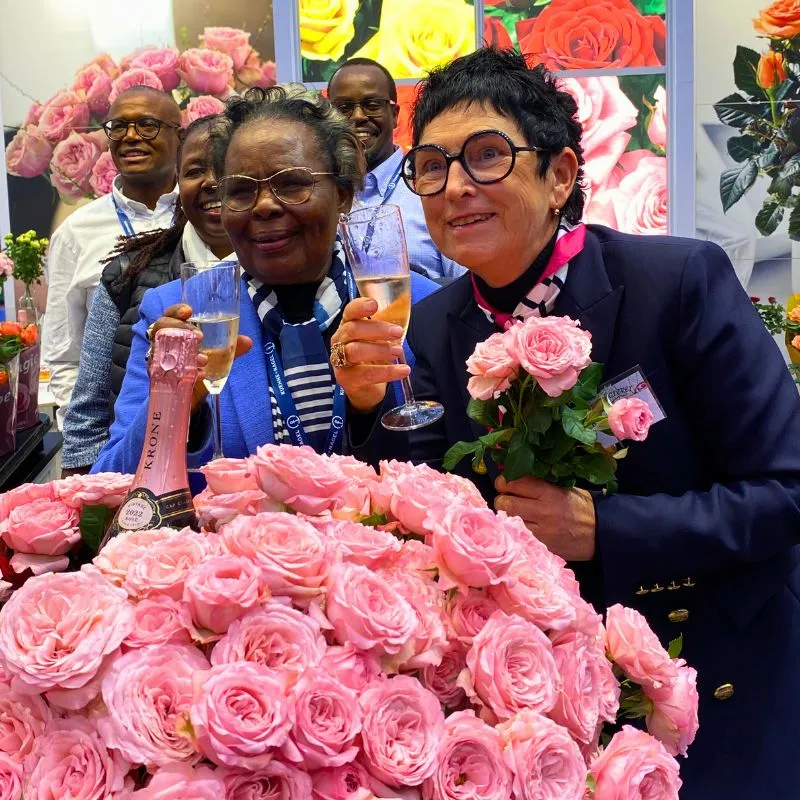For us, this was also a good opportunity to re-introduce Snuf as the successor of Uncle Piet. Bary Verweg, a.k.a. Snuf, used to be one of Big Anton’s foremen in his Sonja® time and left when Anton changed to pot roses. Though Snuf continued to visit and bring presents for Aunt Wil’s birthday, Anton would not forgive this breach of loyalty, though he himself regularly forgot his wife’s birthday. Snuf had joined Terra Blanca, was a top salesman, had traveled, knew all Dutch growers and varieties. He seemed the obvious choice to look after Witte de Wit’s home market. Moreover, his return would add to Witte de Wit’s status in the market and promise for the future. Anton reluctantly agreed.
The Open Days were a big success: Uncle Piet, Piet Lek, Sjef, Big Anton, and, trump card, Snuf proved to be a massive asset for existing clientele and many first-time visitors. It had always been that, like for car makes, customers were very faithful to ‘their’ breeders and propagators. With Snuf in the house and Witte de Wit also venturing into the intermediates, the Terra Blanca and Von Bismarck devotees also found their way into Piet’s showcase. Rose specialists from the different auctions also mingled, as did Seedy, Junior and the other greenhouse boys. Seedy had readily agreed with Snuf’s suggestion that it was very important to learn from the customers.
The Tulp brothers had very visibly shown their interest in Apollo®, only to return a week after the open house to look at a LAVAL code, LA-17452, a yellow-red big-headed bicolor. They wished to set up a 100-plant test and demanded secrecy.
We also noticed that the two big auctions, Aalsmeer and Naaldwijk, started paying more and more attention to breeders. I discussed this with Arent Ruighaver and Piet Staphorst. Through their clocks, the auctions also helped sell illegal flowers of our varieties from Israel, Africa, and Colombia. We should make them aware of this role and responsibility. We arranged a joint meeting with André Mieremet, Managing Director of Aalsmeer Flower Auction.
Although IRBO had officially not been established yet, we presented ourselves on behalf of all internationally operating cut rose breeders. Mieremet was not impressed. Since the auction never formally owned the product, it had not responsibility whatsoever with respect to so-called illegal flowers. “But,” Mieremet continued, “let me make you a more interesting offer. We will collect the royalties for you. And,” going for the knockout after seeing our bewildered faces, “in return we decide which varieties will be introduced, where and in what quantities.” We expected him to burst out laughing, but he was dead serious. Recovered, we each indicated that that was out of the question. Time to leave and descend from this ivory tower.
I was working out my notes of my first Andes rose trip, already some time ago, when I received a call from Anton Speelman: a shipment of illegal bushes ready to be shipped to South America by Rein Haase was stored in the cooler of Gerard Eveleens. I inquired. Uncle Piet only knew the name of this grower, Snuf explained that this 10-hectare farm was right across from Anton’s Potrozen, producing Von Bismarck’s Salsa® and that Gerard was known to be blunt and aggressive at times. I called at lunchtime and could visit that afternoon. I quickly wrote down an idea to tackle the Ecuadorian plantings of Eva®, Icon@ and especially Leonardo®, for which no royalties had been paid.
Eveleens was the biggest Dutch rose producer at the time and 10 hectares of the extremely productive yellow Salsa® meant some 70,000 flowers per day. This required a lot of workers, scarce at the time, unless you resorted to illegal labor from Morocco, referred to as ‘blue ones’.
Big Anton had five such workers, working 6 or 7 days per week, some given typical Dutch first names like ‘Dries’, living in little rooms on top of the coolers, with a constant odor of ongoing cooking in the packing area. They spoke a fair amount of Dutch and had mixed well with the Dutch co-workers. There was a special escape route to the back of the greenhouses in case of a raid.
Eveleens only had Moroccan employees, all illegal, coming and going. If they didn’t follow Gerard’s orders, he would beat them up. I felt uneasy, but prepared when I walked into the packhouse. From the parking area of any Dutch grower, you directly walked into the packing area. Introductions were brief, “Gerard Eveleens. The Haase bushes are here,” opening the cooler, “but there is nothing you can do with them, they are in his wife’s name and have been pledged.” I had a vague idea what this implied, but he seemed well-informed and resolute, so I left it at that. “I’ll look into it, Gerard. Thank you.”
“You know,” he started when walking me to the door, “next time I'll also plant a Witte de Wit variety.” “That would be nice,” I responded. “But I’ll give it a different name and won’t pay royalties.” Seeing my puzzled face, he added “Just like the Zwolsmans.” “You just ask Piet.” He appeared better informed about Witte de Wit than Witte de Wit about him.
Returned to the office and finding the twins and Maurice present, I reported of my encounter and wanted to know more of the Zwolsmans. Dré started. “If Eveleens’ information is correct, there is nothing we can do with these rose bushes. They cannot be seized, as they are legally out of the control of Haase. As to the Zwolsmans, this is a problem of the A.I.V.D. (General Intelligence and Security Service), who work for the Ministry of Agriculture. They refuse to act to protect our breeder’s rights.” In the meantime, Uncle Piet had dug up a file from the bottom of one of his drawers. “Two years ago, we were approached by a rose buyer of Movrie, saying that he bought our Eva®, but with the name ‘Elan’ and produced by Aad and Pim Zwolsman. I contacted them. They said they had seen interesting orange-red roses in a flower stall, bought, propagated, and planted them and that the variety was different from Eva®. Dré brought this to the attention of Pieter Vos of Barents & Barents, who requested the Ministry to intervene through the A.I.V.D. to start a court case for infringement of our breeder’s rights.” Then Dré again, “Pieter Vos has similar cases from other breeders, but the A.I.V.D. refuses to act on behalf of the horticultural industry.” “And the only thing Pieter Vos does is send us an invoice every year,” Maurice concluded. “Would you mind if I take this and the Haase situation up with a young lawyer that I met at the recent CIOPORA meeting?”, I proposed. “As long as he doesn’t send bills it’s fine with me.” “O.k., Maurice, no invoices unless you agree, and Dré, does this include Holland in the ‘monkey countries’?” I made an appointment with the very eager Peter Doedens, who I had met at a recent CIOPORA meeting in The Hague. He had joined Krantz Advocaten a year before, was looking to specialize, and had learned that there were only very few specialists in breeder’s rights. Time to put my Latin illegality-idea into action. Marguerita Rosas had planted half a hectare of Leonardo® and they refused to pay royalties. At the show I also met Johnny Melano of Miami-based Love Bouquets, proudly stating they were selling these flowers to a big American retailer. He had given me his card. I called their general number to ask where I could buy their flowers in the U.S., to which they gave me the names of two big retailers. Next, I found out the headquarters and general fax number of Kroger in Cincinnati, wrote a fax message indicating that they were selling illegal products supplied by Love Bouquets. No doubt they were unaware of this, so we would not put this in the press immediately. Another fax was sent out to another CIOPORA-acquaintance, Fred de Jong of the Dutch division of Kinsinger Brothers. I had agreed to send him fax in English about their Igloo varieties I had run into in the propagation section at Mostert in Burlington, Canada, when I visited Keith Laver. The fact that I had seen Kinsinger pot roses at the recent Roses Inc. show only motivated me more. Who knows. Thinking again about the situation with ‘Elan’, I remembered that when visiting the Belgian Research Station in Melle to conclude the agency agreement for their varieties, Ivan De Wildeman had mentioned that they were linked to the University in Gent and that they had experimented with defining pigments for some of the Melle varieties. Time for a walk in the greenhouse to get away from the paperwork, get some fresh air, touch base with the core business and check with Seedy and Junior what they knew about pigment research.
Spotted by Seedy when entering the greenhouse, he gestured me to stay there, pointing at the little fridge. “Look what Junior brought back from Rome.” That’s right. After the open days, Junior and his wife spent the weekend in Rome. “I asked Junior to persuade Elske to visit the Palatine Hill, so they could accidentally walk into the rose collection, the Viridarium, at the top and Rome’s Rose Garden at Aventine Hill, next to the Circus Maximus' area and this he brought back.” He opened a plastic bag containing a package wrapped in wet newspaper and show some pieces of stems with some foliage and labels reading ‘phoetida’, ‘chinensis viridiflora’, and ‘omeiensis pteracantha’. I copied the names in my notebook and promised Seedy to look them up.
“We will bud these on some of the shrubs we have in the back and cut off the other variety so this can grow. I’m very curious to see what comes out. They should be very rare varieties, one being ‘the stinking rose’, the second completely green end the third having four instead of five petals.”
Seedy knew of pigment research being carried out, often mentioned together with DNA research, then explaining long-windedly that they had nothing to do with each other, the DNA being financially twenty bridges too fat for the horticultural industry—we would have to wait another 25 years for some patent-periods to have expired—and the pigment giving likeliness, but not the 100% certainly needed. Enough for me to contact De Wildeman to arrange a visit to the specific university department and get things organized. The week after I met with Peter Doedens at the stylish offices of Krantz Advocaten on one of the canals in the center of Amsterdam. Peter explained that their senior rates, for Krantz and his two partners, were 300 to 350 guilders per hour and for Peter this was 200, but Krantz had allowed him to do a no cure no pay with Witte de Wit on the condition that I would introduce him to the breeding world. Before I could agree, we first had to figure out what could be possible, combining my breeder’s expertise in terms of legislation and contracts with Peter’s knowledge of criminal and civil law. With the A.I.V.D. unwilling to cooperate, we had to be creative. Within two hours we decided on the following plan of action:
1. Pigment comparison of Eva® and ‘Elan’, although this had not been accepted as evidence in court so far. At least we would learn more from this.
2. If the A.I.V.D. would act, they would confiscate flowers and have a comparative test set up by CPRO (Centre for Plant Breeding and Reproduction Research) in Wageningen. This research center also carried out the trials for the Ministry of Agriculture on which plant breeders’ rights were based. Since they could also be hired for other research, we could approach them for a comparative test. I would contact them. They were always present at CIOPORA meetings, so that wouldn’t be too difficult. If they would agree, we would then, with the help of a rose buyer, have a notary public buy flowers of Eva® and ‘Elan’ at the clock in Aalsmeer. ‘Elan’ was planted some three years ago, so we needed Eva® of the same age. Uncle Piet would know. The notary public would seal the packages and deliver them to CPRO in Wageningen.
3. We would seize the greenhouses and packing area of the Zwolsmans. Since ‘Elan’ was planted in the soil, this was part of the seized real estate and flowers could not be harvested.
When I returned to Benthuizen, Maurice handed me a fax from Marguerita Rosas fax urgently requesting a royalty invoice to pay for their planting of Leonardo®. Yes!
The pigment analysis showed a 99% resemblance. In the report, it was explained that 100% is impossible so that based on the research the varieties could be considered ‘identical’.
Instead of making plants and planting side-by-side, CPRO coded the individual flowers of both parties, mixed them, and had their staff try to tell them apart, which they couldn’t. The report on their letter-paper looked very official.
Peter had arranged the Zwolsman-blitz to be carried out by bailiff and police in the middle of the day, so the neighbors would definitely see. The immigration police were also present to arrest six illegal workers. The greenhouses were sealed.
That evening Pim Zwolsman called Big Anton, in a panic, admitting they had made a mistake and asking Anton to release the greenhouses. This is what we had hoped for. Anton had been instructed to give Pim my phone number, and so he did. I agreed with Pim that they could harvest and auction the flowers, but the proceeds had to be transferred by the auction into a blocked bank account until we had legally sorted everything out. Pim agreed. I would put this in writing, fax it to him and he and his brother would sign and deliver the agreement to Big Anton, living on the same road, who would then co-sign.
The Zwolsmans never signed the statement drawn up by Peter. No doubt, they found the legal terminology too overwhelming. They hired a lawyer, Mr. Stuit, an older and only known lawyer in the industry, who contacted Peter and together they set up the blocked bank account, on which the Zwolsmans had proceeds of their ‘Elan’ flowers deposited, but this stopped after some time.
A few days later, the immigration police again raided the Zwolsman greenhouses, this time arresting three workers. Sometime later, a bailiff was sent in again to formally count the number of plants and confirm that the Zwolsmans were still harvesting. In the meantime, a court case was started, a temporary injunction, to be followed by the main proceedings.
The temporary injunction was set for Amsterdam, Ms. Poelman presiding. It was Peter’s first court case, and it was mine as well. Not knowing if this was allowed, I had decided to bring in extra evidence, at least to make the case more visible. My Movrie rose buyer had bought two big containers of ‘Elan’ and Eva® for me early that morning, with the plastic covers with growers’ and varieties’ names still on. Armed with 600 red roses I walked into the courthouse, catching everybody’s attention, lawyers, accused, witnesses, the lot. I was just in time, introduced myself and asked the judge if I could put them on the corner of her table. Allowed and I purposely put them down in such a way that the judge had her eye on them all the time, of course not being able to see any difference.
I joined Peter, nervous but looking very smart in his black gown, behind our table. Aad Zwolsman and Mr Stuit were behind the other. “Mr. Zwolsman, can you see if these flowers are yours?” Aad walked to the judge’s table, checked the plastic cover. “Yes, they are.” The judge studied the pile carefully and started the proceedings. I had no idea whether we had been over-prepared or the other party under-prepared. When asked about any research they had undertaken to demonstrate the difference between the two varieties, the answer was negative. On the other hand, pigment analysis had never been accepted as legal evidence and the CPRO report was the impressions of a group of people and no sound scientific research, so I had no idea. Peter was confident.
Afterward, I had to take the 600 roses with me. The judge confirmed that I couldn’t offer her any, so I just handed them out in the central hall, sending lawyers and accused home with a smile.
A few months later, just over a year after my visit to Gerard Eveleens, Peter called, jubilant. The Zwolsmans had to pay full royalties, Hfl. 125,000. Legal and research costs and interest on the late payment of royalties, due at the time of planting, would be decided on in the main proceedings[1].
This was a victory for all breeders and a big message: ‘there’s no messing with Witte de Wit’.
[1] The main proceedings took another two years. The Zwolsmans were sentenced to also pay all legal and research costs, plus 5 years’ interest on the royalties. Including the initial Hfl 125,000, they had to (and did) pay over Hfl. 300,000. Of course, the press was informed of all details.







